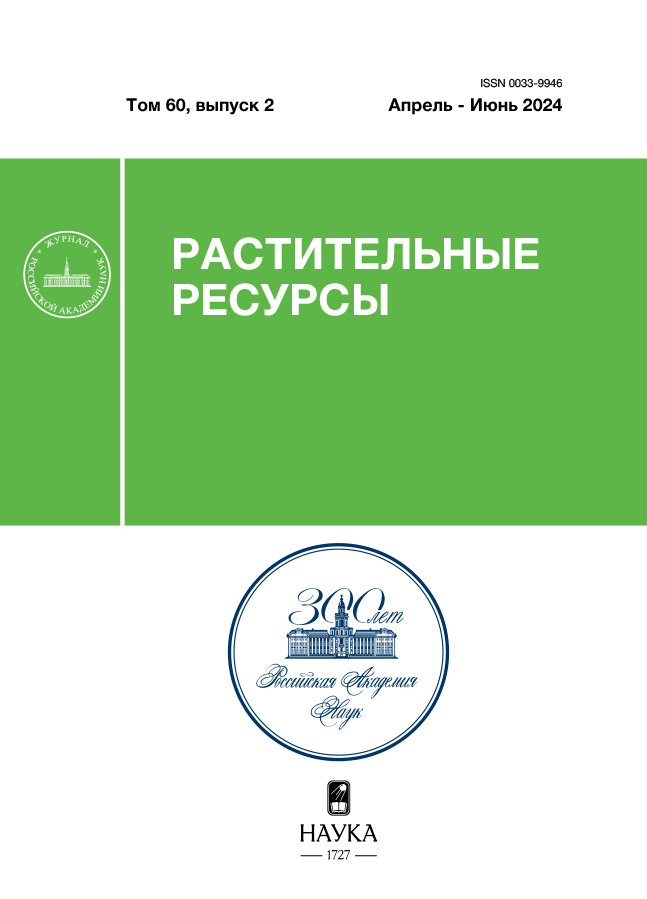Comparative analysis of fatty acid composition of lipids in seeds of various Salvia (Lamiaceae) species
- 作者: Feskova Е.V.1, Leontiev V.N.1, Kisliakova A.A.1, Tychina I.N.2, Gil T.V.2, Anoshenko B.Y.2, Titok V.V.2
-
隶属关系:
- Belarusian State Technological University
- Central Botanical Garden of the National Academy of Sciences of Belarus
- 期: 卷 60, 编号 2 (2024)
- 页面: 104-112
- 栏目: Articles
- URL: https://medjrf.com/0033-9946/article/view/674417
- DOI: https://doi.org/10.31857/S0033994624020072
- EDN: https://elibrary.ru/PYECKH
- ID: 674417
如何引用文章
详细
The article presents the results of a study of the fatty acid composition of seed lipids in some Salvia L. (Lamiaceae) species introduced in the Central Botanical Garden of the National Academy of Sciences of Belarus. Significant variability in the content of fatty acids in the seed lipids of the studied sage species was observed: the average content of palmitic acid was about 7% with the only exception being S. tomentosa Mill. (0.12%). The seeds of S. aethiopis L., S. sclarea L., S. deserta Schang и S. pratensis L. are rich in α-linolenic acid (more than 40%). The content of linoleic acid ranges from 17.3% in S. aethiopis to 64% in S. officinalis L. and S. tomentosa. It has been established that the nature of the fatty acid ratio is species-specific. The contribution of species to the variability of essential fatty acids ranged from 62 to 98% and, therefore, the influence of meteorological conditions ranged from 2 to 38%.
全文:
作者简介
Е. Feskova
Belarusian State Technological University
编辑信件的主要联系方式.
Email: lena.feskova@mail.ru
白俄罗斯, Minsk
V. Leontiev
Belarusian State Technological University
Email: lena.feskova@mail.ru
白俄罗斯, Minsk
A. Kisliakova
Belarusian State Technological University
Email: lena.feskova@mail.ru
白俄罗斯, Minsk
I. Tychina
Central Botanical Garden of the National Academy of Sciences of Belarus
Email: lena.feskova@mail.ru
白俄罗斯, Minsk
T. Gil
Central Botanical Garden of the National Academy of Sciences of Belarus
Email: lena.feskova@mail.ru
白俄罗斯, Minsk
B. Anoshenko
Central Botanical Garden of the National Academy of Sciences of Belarus
Email: lena.feskova@mail.ru
白俄罗斯, Minsk
V. Titok
Central Botanical Garden of the National Academy of Sciences of Belarus
Email: lena.feskova@mail.ru
白俄罗斯, Minsk
参考
- Gharehbagh H. J., Ebrahimi M., Dabaghian F., Mojtabaviet S., Hariri R., Saeedi M., Faramarzi M. A., Khanavi M. 2023. Chemical composition, cholinesterase, and α-glucosidase inhibitory activity of the essential oils of some Iranian native Salvia species. — BMC Complement. Med. Ther. 23: 184. https://doi.org/10.1186/s12906-023-04004-w
- Walker J. B., Sytsma K. J. 2007. Staminal evolution in the genus Salvia (Lamiaceae): molecular phylogenetic evidence for multiple origins of the staminal lever. — Ann. Bot. 100(2): 375—391. https://doi.org/10.1093/aob/mcl176
- Plants of the World Online. Salvia L. https://powo.science.kew.org/taxon/urn: lsid: ipni.org: names:30000096-2
- WFO Plant List. Salvia L. https://wfoplantlist.org/taxon/wfo-4000033888-2023-12
- Plants for a future. Search for: Salvia. https://pfaf.org/user/Plant.aspx? LatinName=Salvia
- European pharmacopoeia 10th Edition. 2019. Council of Europe. Strasbourg. 4318 р.
- The Japanese pharmacopoeia XVIII. (JP XVIII). English version. 2021. The Ministry of Health, Labour and Welfare. 2806 p. https://www.mhlw.go.jp/stf/seisakunitsuite/bunya/0000066597.html
- [The state pharmacopoeia of the Republic of Belarus II. Vol. 2. Quality control of excipients and herbal substances]. 2012. Molodechno. 472 р. (In Russian)
- [State Pharmacopoeia of the Russian Federation XIV. Salviae officinalis folia. Pharmacopoeial article FS.2.5.0051.15.]. Vol. IV. 2018. Moscow. P. 6614—6621. https://pharmacopoeia.regmed.ru/pharmacopoeia/izdanie-14/2/2-5/shalfeya-lekarstvennogo-listya-salviae-officinalis-folia/ (In Russian)
- Lajkovskaya I. V., Titok V. V., Leont’ev V. N., Akulovich I. L. 2004. [Genetic polymorphism of fatty acid composition of oilseed lipids]. — Proceedings of BSTU. Chemistry, Technology of Organic Substances and Biotechnology. 12: 179—183. https://elib.belstu.by/handle/123456789/30840 (In Russian)
- Welch R. W. 1977. A micro-method for the estimation of oil content and composition in seed crops. — J. Sci. Food Agric. 28(7): 635—638. https://doi.org/10.1002/jsfa.2740280710
- Moazzami Farida S. H., Radjabian T., Ranjbar M., Salami S. A., Rahmani N., Ghorbani A. 2016. Fatty acid patterns of seeds of some Salvia species from Iran — A chemotaxonomic approach. — Chem. Biodiversity. 13(4): 451—458. https://doi.org/10.1002/cbdv.201500147
- Subbotina M. A. 2009. [Factors determining the biological value of vegetable oils and fats]. — Bulletin of the Kuzbass State Technical University. 2(72): 86—90. https://journals.kuzstu.ru/article/2416.pdf (In Russian)
- Djuricic I., Calder P. C. 2021. Beneficial Outcomes of Omega-6 and Omega-3 Polyunsaturated Fatty Acids on Human Health: An Update for 2021. — Nutrients. 13(7). 10.3390/nu13072421' target='_blank'>https://doi: 10.3390/nu13072421
- Harris W. S., Mozaffarian D., Rimm E., Kris-Etherton P., Rudel L. L., Appel L. J., Sacks F. 2009. Omega-6 Fatty Acids and Risk for Cardiovascular Disease: A science advisory from the american heart association nutrition subcommittee of the council on nutrition. physical activity, and metabolism; council on cardiovascular nursing; and council on epidemiology and prevention. — Circulation. 119(6): 902—907. 10.1161/circulationaha.108.191627' target='_blank'>https://doi: 10.1161/circulationaha.108.191627
- Johnson G. H., Fritsche K. 2012. Effect of Dietary Linoleic Acid on Markers of Inflammation in Healthy Persons: A systematic review of randomized controlled trials. — Journal of the Academy of Nutrition and Dietetics. 112(7): 1029—1041. 10.1016/j.jand.2012.03.029' target='_blank'>https://doi: 10.1016/j.jand.2012.03.029
- DiNicolantonio J. J., O’Keefe J. H. 2018. Omega-6 vegetable oils as a driver of coronary heart disease: the oxidized linoleic acid hypothesis. — Open Heart. 5(2). 10.1136/openhrt-2018-000898' target='_blank'>https://doi: 10.1136/openhrt-2018-000898
- ICD and ATC codes. https://icdcode.info/russian/atc/code-c10ax.html
- ICD and ATC codes. https://icdcode.info/deutsch/search/p0/s9/Linols%C3%A4ure
- ICD and ATC codes. https://icdcode.info/russian/atc/code-d02ac.html
- [Weather and climate. Weather in Minsk]. http://www.pogodaiklimat.ru/forecast/26850.htm
补充文件









